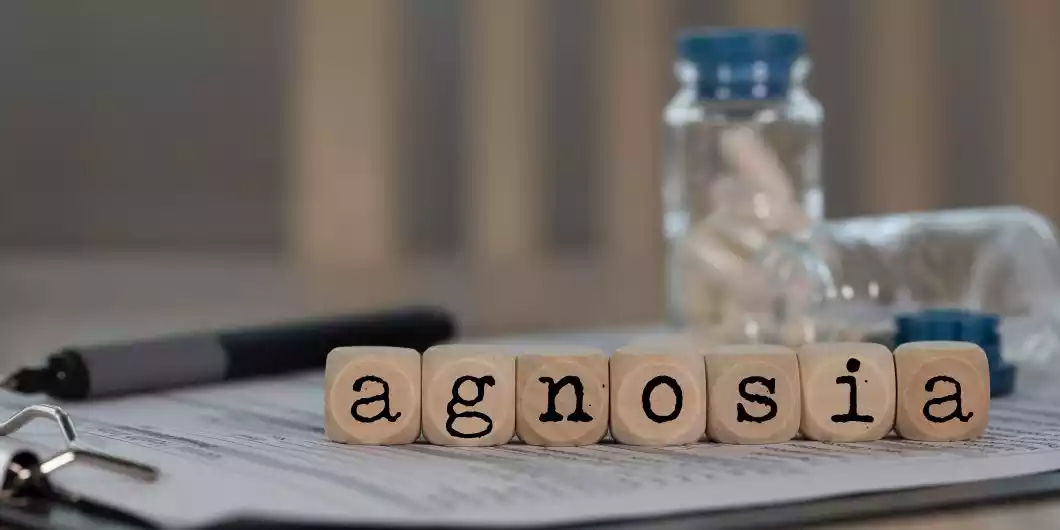Agnosia and Aphasia are two distinct neurological disorders that affect cognition and communication in unique ways. Agnosia is a condition characterized by the inability to recognize and interpret sensory information, such as visual, auditory, or tactile stimuli, despite having intact sensory organs. Aphasia is a language disorder that impairs the ability to understand, express, or use language effectively, often resulting from damage to specific areas of the brain.
While both conditions can impact an individual’s quality of life, understanding the differences between Agnosia and Aphasia is crucial for accurate diagnosis and tailored treatment strategies. This content outline explores the nature, causes, symptoms, diagnosis, and management of these two conditions, aiming to promote awareness and facilitate improved care for those affected.
What is Agnosia?
Agnosia is a neurological disorder characterized by the inability to recognize or interpret sensory information from one or more of the five senses, despite having intact sensory perception. It is a condition in which individuals may experience difficulty in recognizing familiar objects, faces, sounds, or tactile sensations, even though their sensory organs (e.g., eyes, ears, skin) function normally.

Agnosia typically results from damage to specific areas of the brain responsible for processing and integrating sensory input, impairing the individual’s ability to make sense of the sensory information they receive.
Types of Agnosia
Agnosia is a neurological disorder that impairs a person’s ability to recognize or interpret sensory information from one or more of the five senses (sight, hearing, touch, taste, and smell) despite having intact sensory perception. There are several types of agnosia, each affecting a specific sensory modality.
The main types of agnosia include:
- Visual Agnosia: Visual agnosia is the inability to recognize or identify objects or people through visual perception, even though vision itself is intact. There are different subtypes of visual agnosia, such as:
- Apperceptive Visual Agnosia: Individuals with this subtype have difficulty perceiving and organizing visual information, making it challenging to recognize objects or shapes.
- Associative Visual Agnosia: In this subtype, individuals can perceive objects but cannot assign meaning to them or identify them.
- Auditory Agnosia: Auditory agnosia affects the recognition and interpretation of sounds and auditory information. People with auditory agnosia may struggle to understand spoken language, recognize familiar voices, or differentiate between environmental sounds.
- Tactile Agnosia (Astereognosis): Tactile agnosia involves difficulty recognizing objects or understanding their properties through the sense of touch. Individuals may have difficulty distinguishing between objects by touch alone.
- Prosopagnosia: Prosopagnosia is a specific form of visual agnosia that affects the recognition of faces. People with prosopagnosia have trouble recognizing familiar faces, including those of family members or close friends.
- Topographical Agnosia: Topographical agnosia impairs a person’s ability to recognize or navigate familiar environments. Individuals may become disoriented in familiar surroundings, unable to recognize landmarks or find their way.
- Auditory-Verbal Agnosia (Pure Word Deafness): This subtype of auditory agnosia specifically affects the ability to comprehend spoken language while leaving other auditory perception intact. Individuals with auditory-verbal agnosia may hear words as meaningless sounds.
- Olfactory Agnosia (Anosognosia for Smell): Olfactory agnosia is the inability to recognize or interpret odors or smells, despite having a functional sense of smell. It can be a rare form of agnosia.
- Gustatory Agnosia: Gustatory agnosia impairs the recognition and interpretation of tastes. Individuals may struggle to identify flavors or differentiate between different tastes.
Agnosia typically results from damage to specific areas of the brain responsible for processing sensory information. The specific type of agnosia and its severity can vary depending on the location and extent of the brain damage. Diagnosis and treatment are often based on the type and extent of agnosia, as well as the underlying cause.
Causes of Agnosia
Agnosia is a neurological disorder characterized by the inability to recognize or interpret sensory information from one or more of the five senses (sight, hearing, touch, taste, and smell), despite having intact sensory perception. Agnosia is typically caused by damage to specific areas of the brain responsible for processing and integrating sensory input.
The causes of agnosia can include:
-
- Brain Injury: The most common cause of agnosia is brain injury, often resulting from traumatic brain injury (TBI) due to accidents or falls. Other brain injuries, such as those caused by strokes, brain tumors, or infections, can also lead to agnosia.
- Stroke: A stroke occurs when there is a disruption of blood supply to a specific region of the brain. If the stroke affects areas responsible for sensory processing, it can lead to agnosia.
- Brain Tumors: The growth of tumors in the brain can exert pressure on or infiltrate brain regions involved in sensory perception, potentially causing agnosia.
- Neurodegenerative Diseases: Some neurodegenerative conditions, such as Alzheimer’s disease and certain variants of frontotemporal dementia, can lead to agnosia as the disease progresses and damages brain regions involved in sensory processing.
- Head Trauma: Severe head trauma, such as that sustained in car accidents or sports injuries, can result in damage to brain areas responsible for sensory processing, leading to agnosia.
- Infections and Encephalitis: Certain infections of the central nervous system, including viral encephalitis, can damage brain tissue and result in agnosia.
- Vascular Disorders: Besides strokes, other vascular disorders affecting blood vessels in the brain can disrupt blood flow and lead to brain damage, potentially causing agnosia.
- Neurosurgical Procedures: In some cases, neurosurgical procedures to remove brain tumors or manage other neurological conditions can inadvertently damage brain regions responsible for sensory perception.
- Congenital Factors: While less common, agnosia can also be present from birth (congenital agnosia) due to developmental anomalies or genetic factors affecting brain development.
The specific type and severity of agnosia can vary depending on the location and extent of brain damage or dysfunction. Diagnosis and treatment of agnosia often involve a comprehensive neurological evaluation, including imaging studies such as MRI or CT scans, to identify the underlying cause and affected brain regions. Treatment and management strategies may include rehabilitation, therapy, and adaptive techniques to help individuals cope with the challenges of agnosia.
Symptoms and Diagnosis
The symptoms and diagnosis of agnosia depend on the type of agnosia (e.g., visual, auditory, tactile) and the underlying cause. Here, we’ll provide a general overview of the symptoms and the diagnostic process for agnosia:
Symptoms:
- Inability to Recognize Sensory Information: The hallmark symptom of agnosia is the inability to recognize or interpret sensory information despite having intact sensory perception. This can manifest in various ways:
- Visual Agnosia: Difficulty recognizing objects, faces, or even familiar places.
- Auditory Agnosia: Struggling to understand spoken language or recognize familiar voices.
- Tactile Agnosia: Difficulty recognizing objects or understanding their properties through touch.
- Prosopagnosia: Inability to recognize familiar faces.
- Topographical Agnosia: Getting lost in familiar environments or failing to recognize landmarks.
- Difficulty Associating Meaning: People with agnosia may be able to perceive sensory input but cannot assign meaning to it. For example, they may see an object but not know what it is or hear words as meaningless sounds.
- Normal Sensory Perception: Importantly, individuals with agnosia typically have normal sensory perception. Their sensory organs (e.g., eyes, ears, skin) function properly, but the problem lies in the brain’s ability to process and interpret the sensory information.
Diagnosis:
Diagnosing agnosia involves a thorough neurological evaluation, which may include the following steps:
- Clinical Assessment: A neurologist or neuropsychologist will conduct a comprehensive clinical assessment, which may involve interviewing the patient and gathering information about their medical history, the onset of symptoms, and any potential brain injuries or diseases.
- Physical Examination: A physical examination may be performed to rule out other medical conditions and to assess general neurological health.
- Neuroimaging: Imaging studies such as magnetic resonance imaging (MRI) or computed tomography (CT) scans are essential to visualize the brain and identify areas of damage or dysfunction. These scans can help pinpoint the location and extent of the brain damage that may be causing agnosia.
- Neuropsychological Testing: Neuropsychological tests assess cognitive functions, including sensory perception, memory, and language. These tests can help identify specific deficits and determine the type of agnosia.
- Functional Assessment: Assessments may involve specific tasks to evaluate the individual’s ability to recognize objects, faces, or sounds. These tasks can help confirm the presence of agnosia and provide insights into its severity and subtype.
- Rule Out Other Conditions: The diagnostic process also involves ruling out other conditions that may mimic agnosia or contribute to the symptoms, such as dementia, aphasia, or other neurological disorders.
Once a diagnosis of agnosia is confirmed, the next steps typically involve developing a treatment and management plan tailored to the individual’s specific needs. Treatment may involve rehabilitation, therapy, and strategies to help the person adapt to their sensory recognition deficits.
What is Aphasia?
Aphasia is a neurological disorder characterized by a partial or complete loss of the ability to understand, express, or use language effectively, both in spoken and written forms. It typically results from damage to specific areas of the brain responsible for language processing, such as Broca’s area and Wernicke’s area. Individuals with aphasia may have difficulty comprehending spoken or written language, finding the right words, constructing sentences, or expressing their thoughts and ideas.

The severity and specific language deficits associated with aphasia can vary, ranging from mild language impairments to profound communication challenges. Aphasia can significantly impact an individual’s ability to engage in social interactions, convey information, and participate in everyday activities that require language skills. Treatment often involves speech therapy and communication strategies to help individuals with aphasia regain language abilities to the extent possible.
Types of Aphasia
Aphasia is a language disorder that can manifest in various forms, depending on the specific brain areas affected by damage or dysfunction. The main types of aphasia include:
- Broca’s Aphasia (Expressive Aphasia): Broca’s aphasia is characterized by difficulties in producing fluent and grammatically correct speech. Individuals with this type of aphasia often struggle to find the right words and may speak in short, telegraphic sentences. Although their speech is non-fluent, they typically retain good comprehension skills, so they can understand what others are saying.
- Wernicke’s Aphasia (Receptive Aphasia): Wernicke’s aphasia primarily affects language comprehension. People with this type of aphasia often produce speech that is fluent and grammatically correct, but it may be filled with nonsensical or unrelated words. Their speech may be difficult to follow, and they may not realize their language is incomprehensible.
- Global Aphasia: Global aphasia is the most severe form of aphasia. It results in significant impairments in both language production and comprehension. Individuals with global aphasia may produce minimal speech and have great difficulty understanding spoken or written language. This type of aphasia typically occurs after extensive damage to language areas in the brain.
- Anomic Aphasia: Anomic aphasia is characterized by word-finding difficulties. Individuals with this type of aphasia have difficulty recalling specific words, names, or nouns. Otherwise, their speech may be fluent, and their comprehension is relatively intact.
- Conduction Aphasia: Conduction aphasia is marked by difficulties in repeating spoken language. People with this type of aphasia may be able to understand language and produce fluent speech, but they have significant difficulty repeating back words or sentences accurately.
- Transcortical Aphasia: Transcortical aphasias are rare and result from damage to specific areas surrounding the primary language centers. There are two main types:
- Transcortical Motor Aphasia: Individuals with this type of aphasia can produce speech fluently but have difficulty initiating speech or forming meaningful sentences.
- Transcortical Sensory Aphasia: People with this type have fluent but nonsensical speech and struggle with comprehension.
- Mixed Nonfluent Aphasia: This is a combination of Broca’s and Wernicke’s aphasia features, where individuals have difficulty with both language production and comprehension. Their speech may be limited, and they may produce meaningless or incorrect words.
- Primary Progressive Aphasia (PPA): PPA is a neurodegenerative condition where language abilities progressively decline over time. There are three main variants:
- Nonfluent/Agrammatic Variant PPA: Similar to Broca’s aphasia, characterized by difficulty with language production.
- Semantic Variant PPA: Impairs word comprehension and object naming.
- Logopenic Variant PPA: Affects word-finding abilities and sentence repetition.
- Crossed Aphasia: This is a rare type of aphasia that occurs when language centers in the hemisphere opposite to the person’s dominant hand (typically the left hemisphere) are damaged. It may exhibit features of Broca’s or Wernicke’s aphasia.
Each type of aphasia is associated with distinct language deficits, and the specific symptoms can vary in severity from person to person based on the location and extent of brain damage or dysfunction. Diagnosis and treatment are tailored to the individual’s specific type of aphasia.
Causes of Aphasia
Aphasia is primarily caused by damage to specific areas of the brain responsible for language processing. The most common cause of aphasia is a stroke, but other brain-related conditions and injuries can also lead to this disorder.
Here are the main causes of aphasia:
-
- Stroke: Stroke is the leading cause of aphasia. It occurs when there is a disruption in the blood supply to the brain, resulting in brain damage. Ischemic strokes, which are caused by a blocked blood vessel, and hemorrhagic strokes, which result from bleeding in the brain, can both damage language centers and cause aphasia.
- Traumatic Brain Injury (TBI): Severe head injuries, such as those sustained in car accidents, falls, or sports-related incidents, can damage the brain and result in aphasia.
- Brain Tumors: The growth of tumors in the brain can exert pressure on or infiltrate brain regions involved in language processing. This can lead to language impairments, including aphasia.
- Infections and Encephalitis: Certain infections, especially those affecting the central nervous system, such as viral encephalitis, can damage brain tissue and cause aphasia.
- Neurodegenerative Diseases: Some neurodegenerative conditions, like Alzheimer’s disease and certain variants of frontotemporal dementia, can lead to language deficits and aphasia as the disease progresses and damages language-related brain areas.
- Seizures: In some cases, prolonged or severe seizures (status epilepticus) can damage the brain and result in language impairments, including aphasia.
- Vascular Disorders: Besides stroke, other vascular disorders affecting blood vessels in the brain can disrupt blood flow and lead to brain damage, potentially causing aphasia.
- Injury or Damage During Brain Surgery: In rare cases, surgery involving the brain can unintentionally damage language-related areas and lead to aphasia.
The specific type and severity of aphasia can vary depending on the location and extent of the brain damage or dysfunction. The underlying cause of aphasia is crucial in determining the course of treatment and rehabilitation, as well as the potential for recovery. Early diagnosis and intervention are key factors in maximizing the chances of improvement in individuals with aphasia.
Symptoms and Diagnosis
The symptoms and diagnosis of aphasia depend on the specific type and severity of the condition. Here are some common symptoms associated with aphasia and the typical diagnostic process:
Symptoms:
- Language Impairments: The most prominent symptom of aphasia is language impairment, which can manifest in various ways depending on the type:
- Broca’s Aphasia: Individuals may struggle to form complete sentences, often omitting small words and using short, telegraphic phrases. They may have difficulty finding the right words and may experience frustration with speech production.
- Wernicke’s Aphasia: People may produce fluent speech, but it is often filled with neologisms (made-up words) and jargon. Their language may be incomprehensible, and they may not recognize the errors in their speech.
- Global Aphasia: This is characterized by severe language deficits, including limited speech output and minimal comprehension.
- Anomic Aphasia: Individuals primarily struggle with word-finding difficulties. They may frequently pause in conversation to search for specific words.
- Conduction Aphasia: Repetition of spoken language is challenging, and individuals may frequently make paraphasic errors (substituting one word for another).
- Comprehension Issues: In some types of aphasia, comprehension of spoken and written language is impaired to varying degrees. In severe cases like global aphasia, comprehension can be severely limited.
- Reading and Writing Impairments: Aphasia can also affect reading and writing abilities. Individuals may struggle with reading comprehension, have difficulty writing coherent sentences, or produce spelling errors.
Diagnosis:
Diagnosing aphasia typically involves a comprehensive assessment, including the following steps:
- Clinical Assessment: A neurologist, speech-language pathologist (SLP), or neuropsychologist conducts a detailed clinical evaluation. They collect information about the patient’s medical history, the onset of symptoms, and any potential brain injuries or conditions that may have caused aphasia.
- Language Assessment: A thorough language assessment is essential to determine the type and severity of aphasia. This assessment may involve tasks such as naming objects, repeating sentences, and understanding spoken or written language.
- Neuroimaging: Brain imaging studies, such as MRI or CT scans, are often performed to identify any structural abnormalities or areas of damage in the brain. This helps pinpoint the location and extent of brain damage.
- Neuropsychological Testing: Neuropsychological tests assess various cognitive functions, including memory, attention, and language abilities. These tests help differentiate aphasia from other cognitive impairments.
- Language Proficiency Testing: Some standardized language assessments, such as the Western Aphasia Battery (WAB) or the Boston Diagnostic Aphasia Examination (BDAE), may be used to assess language proficiency and classify the type of aphasia.
- Observation and Conversation: Observing the patient in natural conversation and evaluating their spontaneous speech can provide valuable insights into their language abilities and communication challenges.
Once a diagnosis of aphasia is confirmed, treatment and management strategies can be tailored to the individual’s specific type and severity of aphasia. Treatment often involves speech therapy and rehabilitation, which aim to improve language skills and communication abilities. Early diagnosis and intervention are crucial for achieving the best possible outcomes in individuals with aphasia.
Comparison Table of Agnosia and Aphasia
Below is a comparison table of Agnosia and Aphasia to highlight their key differences:
| Feature | Agnosia | Aphasia |
|---|---|---|
| Definition | Inability to recognize or interpret sensory information despite intact sensory perception. | A language disorder characterized by difficulties in understanding, producing, or using language effectively. |
| Types | Visual Agnosia, Auditory Agnosia, Tactile Agnosia, Prosopagnosia, Topographical Agnosia, Auditory-Verbal Agnosia, Olfactory Agnosia, Gustatory Agnosia | Broca’s Aphasia, Wernicke’s Aphasia, Global Aphasia, Anomic Aphasia, Conduction Aphasia, Transcortical Aphasia, Primary Progressive Aphasia, Mixed Nonfluent Aphasia, Crossed Aphasia |
| Primary Impairment | Sensory recognition and interpretation. | Language processing and comprehension. |
| Communication Impact | Difficulty recognizing objects, faces, sounds, or smells. May not understand the meaning of sensory stimuli. | Difficulty understanding spoken or written language, forming sentences, finding words, or expressing thoughts. |
| Sensory Functionality | Sensory organs (e.g., eyes, ears, skin) are typically functional. | Sensory perception is usually intact; the issue lies in language processing. |
| Brain Regions Affected | Damage to areas involved in sensory integration and perception (varying based on the type). | Damage to language centers in the brain, such as Broca’s area and Wernicke’s area. |
| Causes | Brain injuries (e.g., stroke, TBI), tumors, infections, neurodegenerative diseases. | Stroke, TBI, brain tumors, infections, neurodegenerative diseases. |
| Diagnostic Assessment | Neuroimaging, sensory and cognitive testing. | Neuroimaging, language and cognitive assessments. |
| Treatment and Management | Rehabilitation, sensory training, adaptation strategies. | Speech therapy, language rehabilitation, communication strategies, cognitive therapy. |
| Prognosis | Prognosis varies depending on the type, severity, and cause. Some improvement may occur with therapy. | Prognosis depends on the type, severity, and underlying cause. Recovery varies; some individuals may regain language abilities with therapy. |
This table provides a concise overview of the key differences between agnosia and aphasia, including their definitions, types, primary impairments, impact on communication, sensory functionality, affected brain regions, causes, diagnostic assessment, treatment, and prognosis. Understanding these distinctions is crucial for accurate diagnosis and appropriate management of these neurological conditions.
Treatment and Management of Agnosia and Aphasia
The treatment and management of agnosia and aphasia are distinct because they involve different types of neurological deficits. Here are the treatment and management approaches for each condition:
Agnosia:
- Identification of the Underlying Cause: Agnosia often results from brain injuries or diseases. Identifying the specific cause and its extent is crucial for appropriate management.
- Rehabilitation: Agnosia rehabilitation typically focuses on teaching compensatory strategies to help individuals adapt to their sensory recognition deficits. For example, in visual agnosia, patients may learn to rely on their other senses, such as touch or hearing, to identify objects or people.
- Sensory Training: Sensory training exercises can help improve sensory perception and recognition. These exercises may involve repetitive exposure to sensory stimuli to enhance recognition.
- Adaptive Techniques: Individuals with agnosia may benefit from using adaptive techniques and aids, such as labeling objects, using tactile cues, or using memory aids to support recognition.
- Counseling and Support: Providing psychological support and counseling can help individuals and their families cope with the challenges of agnosia, reduce frustration, and improve overall well-being.
Aphasia:
- Speech-Language Therapy: Aphasia treatment primarily involves speech-language therapy provided by a speech-language pathologist (SLP). The therapy may include various approaches:
- Receptive Aphasia: Therapy focuses on improving language comprehension.
- Expressive Aphasia: Therapy helps individuals produce coherent speech and improve word-finding abilities.
- Fluent Aphasia (Wernicke’s): Therapy aims to enhance word meaning and reduce the use of neologisms.
- Nonfluent Aphasia (Broca’s): Therapy focuses on improving sentence construction and speech fluency.
- Augmentative and Alternative Communication (AAC): For individuals with severe aphasia and limited speech, AAC systems like communication boards, tablets, or speech-generating devices can assist in communication.
- Group Therapy: Group therapy sessions provide opportunities for individuals with aphasia to practice communication skills and offer peer support.
- Family and Caregiver Training: Educating family members and caregivers about aphasia and communication strategies is essential for creating a supportive communication environment.
- Cognitive Rehabilitation: Addressing cognitive deficits that often co-occur with aphasia, such as memory and attention, through cognitive rehabilitation can be beneficial.
- Real-Life Communication Practice: Therapy should focus on functional communication skills, helping individuals with aphasia participate in everyday activities and interactions.
- Technology and Apps: There are various apps and computer programs designed to assist individuals with aphasia in language practice and communication.
- Support Groups: Support groups for individuals with aphasia and their families can provide emotional support, share experiences, and offer practical advice on living with aphasia.
Both conditions benefit from early diagnosis and intervention, as well as ongoing support and adaptation to the individual’s specific needs. The goal is to improve communication, enhance quality of life, and help individuals with agnosia and aphasia regain as much independence as possible.
Conclusion
Agnosia and Aphasia are distinct neurological conditions with unique characteristics and impacts. Agnosia involves the inability to recognize or interpret sensory information despite intact sensory perception, while aphasia is a language disorder marked by difficulties in understanding, producing, or using language effectively. Agnosia primarily affects sensory recognition, whereas aphasia primarily affects language processing and comprehension.
Treatment approaches differ as well, with agnosia focusing on sensory training and adaptation, while aphasia management involves speech therapy, language rehabilitation, and communication strategies. Both conditions underline the complexity of the human brain and the importance of tailored interventions to improve the quality of life for affected individuals.































